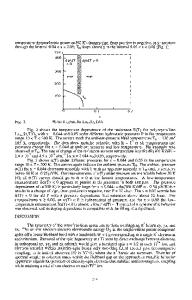Oxygen Diffusion in La 2-x sr x cuo 4-Y
- PDF / 370,598 Bytes
- 6 Pages / 420.48 x 639 pts Page_size
- 106 Downloads / 363 Views
OXYGEN DIFFUSION IN La2_xSrXCuO 4 _Y ELIZABETH J. OPILA, HARRY L. TULLER, BERNHARDT J. WUENSCH AND JOACHIM MAIER* Crystal Physics and Optical Electronics Laboratory Department of Materials Science and Engineering Massachusetts Institute of Technology Ctmbridge, MA 02139 also Max Planck Institute for Metal Research Heisenbergstr. 5, D-7000 Stuttgart 80 ABSTRACT Oxygen diffusivities in La2_xSrxCuO4_y (x=0, 0.07, 0.09, 0.12) single crystals were measured using an is02 exchange technique followed by SIMS profiling. An interstitial diffusion model is proposed to explain the decrease in the oxygen diffusivity with increasing strontium content. INTRODUCTION It is known that the superconducting properties of La2_xSrxCuO4_y depend on x and the oxygen content of the material. Knowledge of the oxygen diffusivity enables the accurate determination of annealing times and temperatures required to achieve the desired properties. Oxygen diffusivities have been measured by Routbort et al. [1] in polycrystalline La2_xSrxCu04_v (x=-0.1, 0.15, 0.20) using 1802 exchange followed by SIMS analysis. This technique in principle allows the direct detegination of the oxygen self diffusion coefficient since the 0 diffusion profile is obtained under conditions where the chemical potential of oxygen is constant. No data have been reported for oxygen diffusion in single crystals of this material prior to this study. The study of diffusivities in single crystals rather than polycrystalline materials has several advantages. First, short circuiting grain boundary contributions to diffusion can be eliminated. Second, diffusivities can be studied as a function of crystallographic orientation. By examining the effect of strontium substitution for lanthanum on the oxygen diffusivity, conclusions about the defect chemistry and transport mechanism of this system may be made. The data presented in this paper represents our efforts to date towards achieving these goals. DEFECT CHEMISTRY The defect chemistry of this system may be examined in terms of the effect of strontium additions on the oxygen defect structure. Four regimes of defect behavior may be considered. First, for the undoped material, oxygen excess in the form of oxygen interstitials is reported to exist under oxidizing conditions [2]. These interstitials are compensated by holes. In the second regime the strontium on lanthanum sites [SrLa'] is compensated by holes. This regime (in oxygen) is known to extend to strontium values of at least x=0.15 from Mat. Res. Soc. Symp. Proc. Vol. 209. 01991 Materials Research Society
796
chemical analysis and TGA data [3]. At higher levels of x, [SrLa'] is compensated by oxygen vacancies. Finally, for large values of x, defect association of [SrLa'] and oxygen vacancies is expected to take place. By considering the following set of defect equilibria expressions, each of the key defect species can be evaluated in terms of the strontium concentration, P02 and temperature. The p02 dependence (slope 1/6 in regime 1, slope 0 in regime 2, and slope 1/4 in regim
Data Loading...











